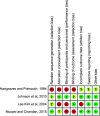Comparing the Sedative Effect of Oral and Intranasal Midazolam and their Effect on Behavior in Pediatric Dental Patients
- PMID: 35528500
- PMCID: PMC9016920
- DOI: 10.5005/jp-journals-10005-2117
Comparing the Sedative Effect of Oral and Intranasal Midazolam and their Effect on Behavior in Pediatric Dental Patients
Abstract
Aim: To systematically identify and evaluate the available literature based on the sedative effect of oral midazolam compared with midazolam administered intranasally and also compare their effect on behavior of pediatric dental patients.
Objective: This systematic review compares the sedative effect and the effect on behavior with oral midazolam and intranasal midazolam.
Methods: A search was undertaken through PubMed Central, Cochrane Database of Systematic Reviews, Lilacs, Science Direct and SIGLE. All the studies included the comparison of the sedative effect of oral and intranasal midazolam. Database search identified 178 articles. 165 articles were excluded based on titles and duplication. Abstract and complete text of 13 articles were thoroughly evaluated. Four articles were included based on the inclusion criteria to meet the criteria. The selected studies analyzed the children's behavior or anxiety by oral midazolam in comparison to intranasal midazolam administration.
Results: Among the four studies included in the present review, risk of bias was high in all the articles. The high risk was obtained due to inadequate blinding of personnel and participants in the study, improper allocation concealment and inadequacy in blinding of the outcome assessment. Also, difference observed between oral and intranasal midazolam routes on behavior and sedation level in the studies included in this review was not statistically significant.
Conclusion: Studies comparing the effect on behavior of oral and intranasal midazolam in children are limited. More number of high-quality clinical trials evaluating the sedative effect and effect on behavior of oral and intranasal midazolam in pediatric dental patients is required.
How to cite this article: Kotian N, Subramanian EMG, Jeevanandan G. Comparing the Sedative Effect of Oral and Intranasal Midazolam and their Effect on Behavior in Pediatric Dental Patients. Int J Clin Pediatr Dent 2022;15(1):128-134.
Keywords: Midazolam; Pediatric dentistry; Sedation; Systematic review.
Copyright © 2022; The Author(s).
Conflict of interest statement
Source of support: Nil Conflict of interest: None
Figures
Similar articles
-
Sedative and Behavioral Effects of Intranasal Midazolam in Comparison with Other Administrative Routes in Children Undergoing Dental Treatment - A Systematic Review.Contemp Clin Dent. 2021 Apr-Jun;12(2):105-120. doi: 10.4103/ccd.ccd_470_20. Epub 2021 Jun 14. Contemp Clin Dent. 2021. PMID: 34220149 Free PMC article. Review.
-
Comparison of the Sedative Effect of Inhaled Nitrous Oxide and Intranasal Midazolam in Behavior Management and Pain Perception of Pediatric Patients: A Split-mouth Randomized Controlled Clinical Trial.Int J Clin Pediatr Dent. 2021;14(Suppl 2):S111-S116. doi: 10.5005/jp-journals-10005-2085. Int J Clin Pediatr Dent. 2021. PMID: 35645472 Free PMC article.
-
Comparative Evaluation of Oral and Intranasal Administration of Midazolam as Preanesthetic Medication in Pediatric Dental Patients Treated under General Anesthesia.Int J Clin Pediatr Dent. 2024 Aug;17(8):881-886. doi: 10.5005/jp-journals-10005-2941. Int J Clin Pediatr Dent. 2024. PMID: 39372344 Free PMC article.
-
Intranasal sedation using ketamine and midazolam for pediatric dental treatment (NASO): study protocol for a randomized controlled trial.Trials. 2017 Apr 11;18(1):172. doi: 10.1186/s13063-017-1919-2. Trials. 2017. PMID: 28399933 Free PMC article. Clinical Trial.
-
Comparative evaluation of efficacy and safety of nitrous oxide and midazolam for conscious sedation in pediatric dental patients: a systematic review and meta-analysis.J Dent Anesth Pain Med. 2025 Jun;25(3):161-182. doi: 10.17245/jdapm.2025.25.3.161. Epub 2025 May 30. J Dent Anesth Pain Med. 2025. PMID: 40521429 Free PMC article. Review.
Cited by
-
Influence of Temperament on the Acceptance of Two Conscious Sedation Techniques in Toddlers Undergoing Dental Treatment: A Randomised Cross Over Trial.Pain Res Manag. 2023 Aug 22;2023:6655628. doi: 10.1155/2023/6655628. eCollection 2023. Pain Res Manag. 2023. PMID: 37649959 Free PMC article. Clinical Trial.
-
Evaluating the Quality of Systematic Reviews on Pediatric Sedation in Dentistry: An Umbrella Review.J Clin Med. 2024 Jun 17;13(12):3544. doi: 10.3390/jcm13123544. J Clin Med. 2024. PMID: 38930074 Free PMC article. Review.
-
Assessment of Pain During Pediatric Dental Treatment Using Different Sedative Agents: A Crossover Trial.Cureus. 2023 Jul 11;15(7):e41676. doi: 10.7759/cureus.41676. eCollection 2023 Jul. Cureus. 2023. PMID: 37575859 Free PMC article.
-
A Comparative Study of Parent and Child Perspectives on Using the Intranasal Mucosal Atomization Device for Behavior Management in Pediatric Dental Sedation.Cureus. 2024 Apr 23;16(4):e58832. doi: 10.7759/cureus.58832. eCollection 2024 Apr. Cureus. 2024. PMID: 38784320 Free PMC article.
References
-
- American Academy of Pediatrics, American Academy of Pediatric Dentistry, Coté CJ, et al. Guidelines for monitoring and management of pediatric patients during and after sedation for diagnostic and therapeutic procedures: an update. Pediatrics. 2006;118(06):2587–2602. doi: 10.1542/peds.2019-1000. - DOI - PubMed
Publication types
LinkOut - more resources
Full Text Sources



